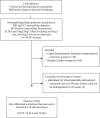Evaluation of X chromosome inactivation in endemic Tunisian pemphigus foliaceus
- PMID: 36349750
- PMCID: PMC9747557
- DOI: 10.1002/mgg3.2080
Evaluation of X chromosome inactivation in endemic Tunisian pemphigus foliaceus
Abstract
Background: Almost 5% of the world's population develops an autoimmune disease (AID), it is considered the fourth leading cause of disability for women, who represent 78% of cases. The sex ratio when it comes to the most prevalent AID varies from 9:1 in systemic lupus erythematosus (SLE) to 13:1 in endemic Tunisian pemphigus foliaceus (PF).
Methods: To test the potential involvement of skewed x-inactivation in the pathogenesis of Tunisian PF, we analyzed the methylation status of a highly polymorphic CAG repeat in the androgen receptor gene and evaluated the x chromosome inactivation (XCI) patterns in peripheral blood-leukocyte-derived DNA samples of female patients with PF (n = 98) compared to healthy control (HC) subjects (n = 150), as well as female patients with SLE (n = 98) were enrolled as a reference group.
Results: XCI status was informative for 50 of the 98 PF patients (51%) and 70 of the 150 HC women (47%). Extremely skewed XCI patterns were more frequent in PF and SLEwomen than HC, but the difference was statistically significant only in women with SLE. No statistical difference was observed in XCI patterns between PF and SLE patients. PF phenotype-XCI correlation analysis revealed that (i) skewed XCI patterns may be involved in the disease's subtype and (ii) it was more pronounced in the endemic group than the sporadic one. Furthermore, preferential XCI showed an increase in heterozygote genotypes of PF's susceptibility polymorphisms in immunity-related X genes (FOXP3, AR, and TLR7) in PF patients compared to HC.
Conclusion: Our results suggest that skewed XCI could lead to hemizygosity of X-linked alleles that might unmask X-linked deleterious alleles.
Keywords: X chromosome inactivation; autoimmune disease; pemphigus foliaceus.
© 2022 The Authors. Molecular Genetics & Genomic Medicine published by Wiley Periodicals LLC.
Conflict of interest statement
We declare having no conflicts of interest concerning published information in this study.
Figures
References
-
- Abida, O. , Bahloul, E. , Elloumi, N. , Toumi, A. , Tahri, S. , Ben Jmaa, M. , Fakhfakh, R. , Mahfoudh, N. , Turki, H. , & Masmoudi, H. (2020). Toll‐like‐receptor gene polymorphisms in Tunisian endemic pemphigus Foliaceus. BioMed Research International, 2020, 1–11. 10.1155/2020/6541761 - DOI - PMC - PubMed
-
- Abida, O. , Kallel‐Sellami, M. , Joly, P. , Ben Ayed, M. , Zitouni, M. , Masmoudi, A. , Mokni, M. , Fezzaa, B. , Ben Osman, A. , Kammoun, M. , Gilbert, D. , Turki, H. , Tron, F. , Masmoudi, H. , Makni, S. , & The Franco‐Tunisian group of survey and research on pemphigus . (2009). Anti‐desmoglein 1 antibodies in healthy related and unrelated subjects and patients with pemphigus foliaceus in endemic and non‐endemic areas from Tunisia. Journal of the European Academy of Dermatology and Venereology, 23(9), 1073–1078. 10.1111/j.1468-3083.2009.03265.x - DOI - PubMed
-
- Abida, O. , Masmoudi, A. , Rebaï, A. , Ben Ayed, M. , Mahfoudh, N. , Kallel‐Sellami, M. , Makni, S. , Joly, P. , Gilbert, D. , Makni, H. , Tron, F. , Masmoudi, H. , & Turki, H. (2009). The familial feature of Tunisian endemic pemphigus foliaceus. British Journal of Dermatology, 161(4), 951–953. 10.1111/j.1365-2133.2009.09386.x - DOI - PubMed
-
- Abida, O. , Zitouni, M. , Kallel‐Sellami, M. , Mahfoudh, N. , Kammoun, A. , Ben Ayed, M. , Masmoudi, A. , Mokni, M. , Fezzaa, B. , Ben Osman, A. , Kammoun, M. R. , Turki, H. , Makni, H. , Gilbert, D. , Joly, P. , Tron, F. , Makni, S. , Masmoudi, H. , & the Franco‐Tunisian Group for Survey and Research on Pemphigus . (2009). Tunisian endemic pemphigus foliaceus is associated with the HLA‐DR3 gene: Anti‐desmoglein 1 antibody‐positive healthy subjects bear protective alleles. British Journal of Dermatology, 161(3), 522–527. 10.1111/j.1365-2133.2009.09207.x - DOI - PubMed
-
- Allen, R. C. , Zoghbi, H. Y. , Moseley, A. B. , Rosenblatt, H. M. , & Belmont, J. W. (1992). Methylation of HpaII and HhaI sites near the polymorphic CAG repeat in the human androgen‐receptor gene correlates with X chromosome inactivation. American Journal of Human Genetics, 51(6), 1229–1239. - PMC - PubMed
Publication types
MeSH terms
Supplementary concepts
LinkOut - more resources
Full Text Sources
Medical
Research Materials


